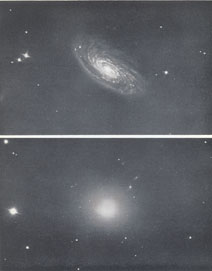


Family Characteristics of Nebulae
The nebulae were found to be members of a single. homogeneous family. They are all of the same general order of intrinsic luminosity (or candle-power), and they exhibit a common pattern of rotational symmetry about dominating central nuclei. Although the structural forms vary widely, they fall naturally into an ordered sequence in which the fundamental pattern varies systematically from one end to the other. The sequence begins with compact globular nebulae and proceeds through a series of flattening ellipsoids into a series of unwinding spirals. Many other characteristics, including colour, spectral type, and resolution into stars, also vary systematically through the sequence; consequently, the sequence has been adopted as the basis for the general classification of nebulae.
It is possible that the sequence represents the life-history of nebulae. The observations alone are not decisive, but they follow with remarkable fidelity the course indicated-by the theory of evolution developed by Sir James Jeans. If the theory is even approximately correct, we may provisionally assume that the globular nebulae are young and the open spirals are old. Our own stellar system, an open spiral, would then be classed as an old, mature organization.
The life-history of nebulae is a question for future investigation. For the present we are concerned with the sequence as evidence of a family relationship which permits all the nebulae to be reduced to a standard type and discussed as a single homogeneous group. In this way we can describe the average nebula, and determine numerically the scatter of various characteristics around the average values. The scatter is not great; the nebulae are curiously similar.
This fact greatly simplifies the interpretation of data from surveys. The intrinsic luminosities of nebulae are so alike that, where large members are concerned, they can often be treated, for statistical purposes, as though they were precisely constant. The apparent faintness of the nebulae then indicate their relative distances. The final step, the determination of absolute distances, depends upon the numerical value of the mean intrinsic luminosity. This essential datum could be evaluated only when the mean distance had been derived for a representative sample collection of nebulae.
 |
PLATE II a. N.G.C. 4501. Messier 88. b.
N.G.C. 4486. Messier 87
A cluster, since it is a sample collection of many nebulae, all at the
same distance, furnishes information concerning the dispersion in size,
luminosity, and structure among nebulae. The Virgo cluster, at a
distance of 7.5 million light-years, is the
nearest, and offers the most detailed information. All types of nebulae
are found, although the frequency of early types, and especially of
elliptical nebulae, is much higher in the cluster than in the general
field.
|